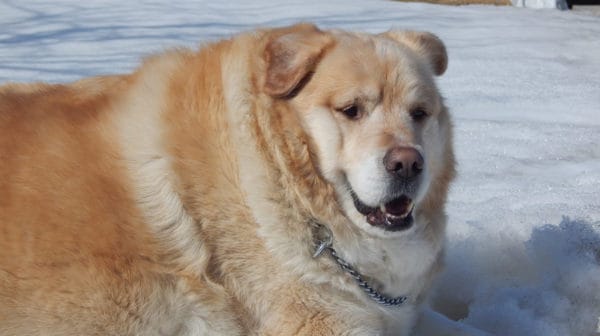Dog eye problems can be extremely stressful for canines. From redness, pain and irritation to discharge and vision issues, no dog wants to endure eye issues. Regular veterinary care is essential for preventing eye problems in dogs, and pet parents should be aware of the signs and symptoms of common eye disorders.
1. Conjunctivitis
Also known as pink eye, conjunctivitis is an infection characterized by redness, inflammation and an excessive amount of goopy eye gunk. Conjunctivitis can be bacterial or viral, but similar symptoms can also be triggered by allergic reactions and irritating foreign materials like dirt or dust. While bacterial cases of pink eye require prescription antibiotics, other underlying triggers can be addressed with sterile eye washes.
“If your dog has allergic conjunctivitis (red, teary eyes after being outside in the spring and early summer), flush the eyes with sterile saline or artificial tears after your dog goes outside to remove irritating allergens,” advises Dr. Sarah J. Wooten, DVM, CVJ, consulting veterinarian for Big Barker.
Burt’s Bees Care Plus+ Relieving Dog Eye Rinse is a gentle wash solution used to address the symptoms of many common dog eye problems. Working to soothe and cleanse your dog’s eyes, this wash can provide much-needed relief to itchy or irritated eyes. It is also pH-balanced with no sulfates or colorants.
2. Tear Stains
When a dog’s eyes are irritated, he produces excessive tears. Most dogs have small holes in the eye that drain tears away and down the throat. Some dogs cannot properly drain away these tears, causing the dog eye discharge to spill out of the eye and create reddish-brown streaks down the face. Inward-turning eyelids, excessive hair growth around the eye, shallow eye sockets, and blocked tear duct drainage holes can exacerbate this problem. Dogs with white fur or long fur, as well as short-nosed breeds (Pugs, Maltese and Shih-tzu) are more prone to visible staining from dog eye discharge.
Angels’ Eyes Gentle Tear Stain Wipes for Dogs are recommended to help remove dried mucus secretions, discharge and tear stains. These wipes help reduce the risk of eye irritations and itching caused by foreign matter. Four Paws Crystal Eye Tear Stain Remover quickly and gently gets rid of tear stains and any other stains from your pet’s fur. It’s gentle enough to use on pets of any age. NaturVet Tear Stain Dog & Cat Soft Chews help support your pet’s immune system, lubricate mucous membranes and contain ingredients such as eyebright, cranberry extract and marshmallow root to eliminate ugly eye stains.
3. Cherry Eye
One of the more common dog eye problems is cherry eye. While you have two eyelids, your dog has three. The third, typically hidden eyelid, is located in the inner corner of the eye. In some dogs, the ligaments that hold the tear-producing gland within the eyelid in place become weak. When these ligaments become loose, the gland pops out of its location, looking much like a red cherry stuck in the corner of the eye. Cherry eye is typically genetic and requires surgery to address.
4. Corneal Damage
You can injure your cornea by rubbing your eyes too hard or leaving your contact lens in too long. Dogs can similarly injure the clear layer of tissue that covers the cornea. While it’s unlikely your dog has fallen asleep in front of the television with his contacts in, he may have pawed at his eye or raced by a bush that poked him in the eye.
“Symptoms of a corneal scratch or ulcer include a red eye in dogs and excessive tearing,” says Dr. Wooten. “This condition is usually uncomfortable and can be downright painful.” If you suspect an acute trauma to your dog’s eye, Dr. Wooten recommends taking him to the veterinarian, as antibiotic drops or ointments may be necessary. In the meantime, keep your dog in a calm, dark area, as light will aggravate the condition.
5. Dry Eye
Officially called keratoconjunctivitis sicca (KCS), the easier-to-pronounce dry eye is a disease that means your dog’s tear glands produce fewer tears than normal. Tears serve an important function by lubricating the surface of the eye to remove foreign materials, and dry eyes can lead to corneal scratches or ulcers and other problems. Red eye in dogs may signal KCS. He may also paw at his eye frequently.
While surgery can be required in extreme cases, you can help alleviate symptoms of dry eye by applying an artificial tear solution regularly. Optixcare Dog & Cat Eye Lube Plus Lubricating Gel keeps your dog’s eyes soothed and moisturized with carbomer, a special gel that acts as artificial tears, and hyaluron, a super hydrator that can hold a hundred times its weight in water. One or two drops keep your dog’s eyes moist and comfortable.
6. Lenticular Sclerosis and Cataracts
These conditions, while different in terms of seriousness, are both characterized by a cloudy eye or loss of vision, especially at night. “However, lenticular sclerosis is a normal old age change noted in the eye. It results from thickening of the lens, and no treatment is necessary,” says Dr. Wooten.
“On the other hand, cataracts also show up as cloudy changes within the eye, but as cataracts advance, they become more opaque and sparkly,” describes Dr. Wooten. “Cataracts impede vision and can be a sign of undiagnosed diabetes in dogs, so it is important to schedule an appointment with your veterinarian if you notice any changes within the eye.” A veterinarian can determine whether your dog’s milky eyes are lenticular sclerosis or cataracts.
VetriScience Canine Plus Senior Multivitamin Everyday Health Bite-Sized Dog Soft Chews are ideal for geriatric dogs to support heart, liver, brain and eye function, as well as physical and mental well-being. These treats incorporate over 25 nutrients to meet the health needs of your furry friend by focusing on major processes like the cardiovascular system, brain and liver to keep your active senior dog healthy and feeling spry.
7. Glaucoma
When the pressure within the eye is disrupted, your dog’s eyesight is at risk. Glaucoma is characterized by pain, redness, increased tearing, cloudiness, dilated pupils and a bulging eye. Dr. Wooten says to call your veterinarian immediately if you suspect glaucoma, as it can lead to blindness.
If you notice any of these symptoms in your pup, or are worried about dog eye problems, be sure to see your vet right away to discover the cause and to find the right dog eye care solution.

Caitlin Boyle is a writer from Charlotte, North Carolina. Her hobbies including trail running and planning fantasy vacations. She has two dogs, Maggie and James, and a cat that believes he’s a dog, Ferguson.
Share:















